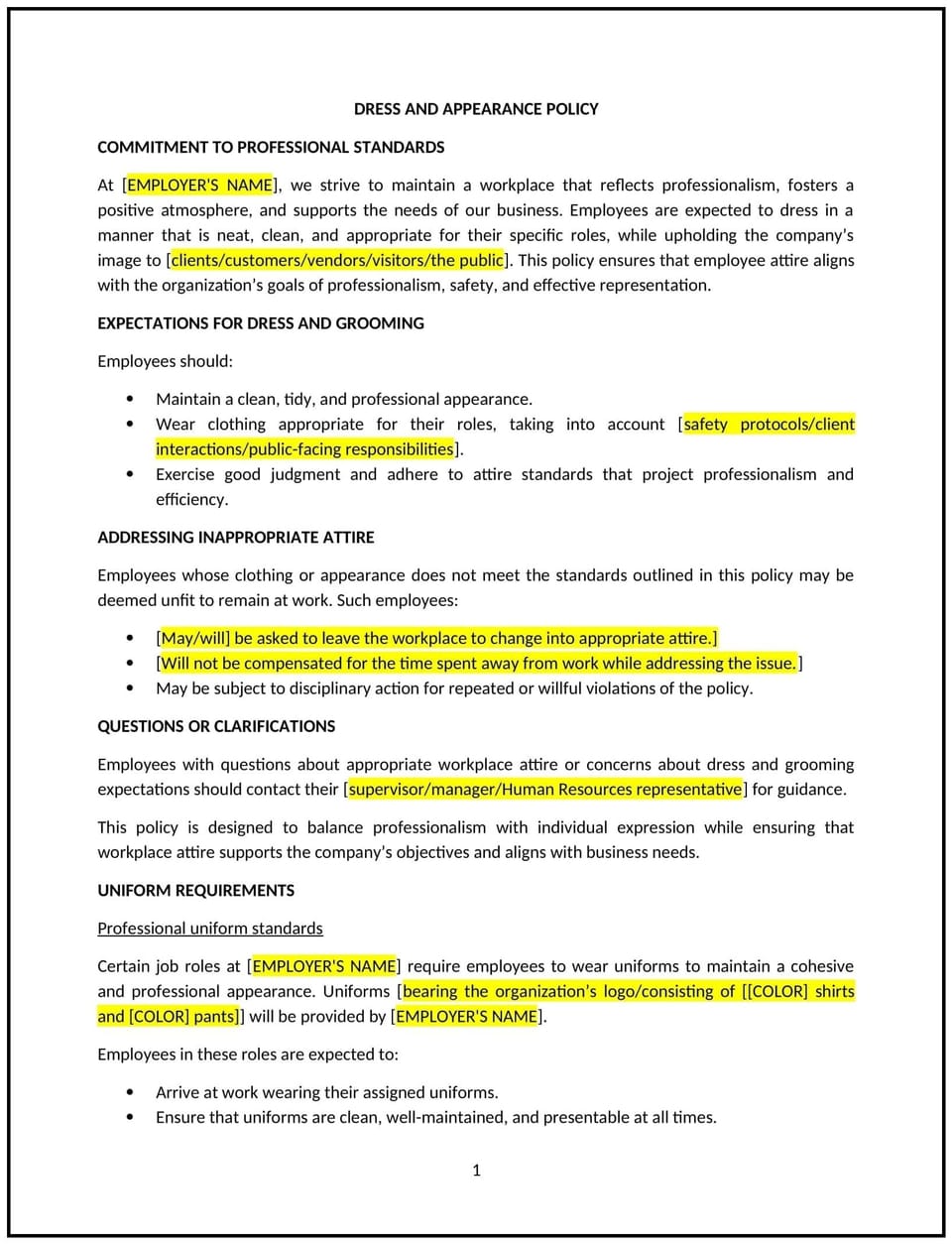Dress and appearance policy (Connecticut): Free template

Dress and appearance policy (Connecticut)
A dress and appearance policy helps Connecticut businesses set clear guidelines for employee attire and grooming in the workplace. This policy outlines the expectations for professional appearance, balancing the need for comfort with the company’s standards for representing its brand and maintaining a respectful, inclusive work environment.
By implementing this policy, businesses can promote a professional image, foster inclusivity, and ensure that employees’ attire supports the company’s values while maintaining respect for diversity.
How to use this dress and appearance policy (Connecticut)
- Define expectations: Specify the general dress code for the workplace, including guidelines for business casual, formal, or uniformed attire, and any exceptions based on specific roles or work environments.
- Set grooming standards: Outline expectations for personal grooming, such as hair, hygiene, and makeup, ensuring they reflect the company’s standards for professionalism and respect.
- Address special accommodations: Provide guidelines for employees who may require accommodations based on religious or medical reasons, allowing for flexibility while maintaining professional standards.
- Promote inclusivity: Ensure that the dress code is inclusive and non-discriminatory, allowing employees to express their personal identity and cultural background in a respectful manner.
- Clarify enforcement: Define the consequences for non-compliance, such as verbal warnings or other disciplinary actions, and provide guidance on how dress code issues will be addressed consistently.
Benefits of using this dress and appearance policy (Connecticut)
This policy offers several benefits for Connecticut businesses:
- Promotes a professional image: Establishes clear guidelines for employee attire that supports the company’s brand and reputation with clients, customers, and visitors.
- Fosters respect and inclusivity: Encourages employees to express themselves while maintaining a respectful and professional environment.
- Ensures consistency: Provides a consistent standard for employees to follow, reducing confusion and ensuring that everyone adheres to the same expectations.
- Reduces distractions: Minimizes potential distractions caused by inappropriate or unprofessional attire, helping employees stay focused on work.
- Supports compliance: Helps businesses comply with local, state, and federal laws regarding workplace appearance, ensuring that the policy is both fair and legally sound.
Tips for using this dress and appearance policy (Connecticut)
- Communicate expectations clearly: Ensure that employees understand the dress code policy and know what is considered appropriate attire for different work settings.
- Consider employee feedback: Be open to employee input on the policy, especially for roles with more flexibility, to ensure it is fair and inclusive.
- Maintain flexibility: Provide accommodations for employees who need flexibility due to medical, religious, or cultural reasons while maintaining professionalism.
- Monitor compliance consistently: Apply the policy consistently and fairly to all employees, addressing issues promptly and respectfully.
- Review periodically: Update the policy to reflect changes in company culture, industry standards, or legal requirements to ensure it remains relevant and effective.
Q: How does this policy benefit my business?
A: The policy ensures a professional and consistent image for the company, promotes respect and inclusivity in the workplace, and reduces distractions caused by inappropriate attire.
Q: What types of attire are considered appropriate under this policy?
A: The policy should specify acceptable attire based on the company’s environment, such as business casual, formal attire, or uniforms, with allowances for exceptions based on role or work conditions.
Q: Can employees wear personal items that reflect their identity or culture?
A: Yes, the policy should allow for personal expression in a respectful and professional manner, accommodating employees’ cultural, religious, and gender identity needs without compromising the company’s standards.
Q: What happens if an employee does not follow the dress code policy?
A: The policy should outline the process for addressing non-compliance, such as verbal warnings or more formal disciplinary actions, and provide a clear, consistent approach for resolving any issues.
Q: How often should this policy be reviewed?
A: The policy should be reviewed annually or whenever there are updates to Connecticut laws, changes in business practices, or employee feedback to ensure it remains effective and relevant.
This article contains general legal information and does not contain legal advice. Cobrief is not a law firm or a substitute for an attorney or law firm. The law is complex and changes often. For legal advice, please ask a lawyer.


